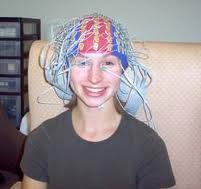Will EEG Data Analysis Help Diagnose Autism?
 Computer analysis of EEG patterns suggests a potential diagnostic test for autism (Eureka Science News):
Computer analysis of EEG patterns suggests a potential diagnostic test for autism (Eureka Science News):
“Widely available EEG testing can distinguish children with autism from neurotypical children as early as age 2, finds a study from Boston Children’s Hospital. The study is the largest, most rigorous study to date to investigate EEGs as a potential diagnostic tool for autism, and offers hope for an earlier, more definitive test. Researchers Frank H. Duffy, MD, of the Department of Neurology, and Heidelise Als, PhD, of the Department of Psychiatry at Boston Children’s Hospital, compared raw EEG data from 430 children with autism and 554 control subjects, ages 2 to 12, and found that those with autism had consistent EEG patterns indicating altered connectivity between brain regions — generally, reduced connectivity as compared with controls.”
Study: A stable pattern of EEG spectral coherence distinguishes children with autism from neuro-typical controls — a large case control study (BMC Medicine). Provisional Abstract:
- Background: The autism rate has recently increased to 1 in 100 children. Genetic studies demonstrate poorly understood complexity. Environmental factors apparently also play a role. Magnetic resonance imaging (MRI) studies demonstrate increased brain sizes and altered connectivity. EEG coherence studies confirm connectivity changes. However, genetic‑, MRI‑, and/or EEG-based diagnostic tests are not yet available. The varied study results likely reflect methodological and population differences, small samples, and for EEG, lack of attention to group-specific artifact.
- Conclusions: Classification success suggests a stable coherence loading pattern that differentiates ASD- from C‑group subjects. This might constitute an EEG coherence-based phenotype of childhood autism. The predominantly reduced short-distance- coherences may indicate poor local network function. The increased long-distance- coherences may represent compensatory processes or reduced neural pruning. The wide average spectral range of factor loadings may suggest over-damped neural networks.
Related articles:


